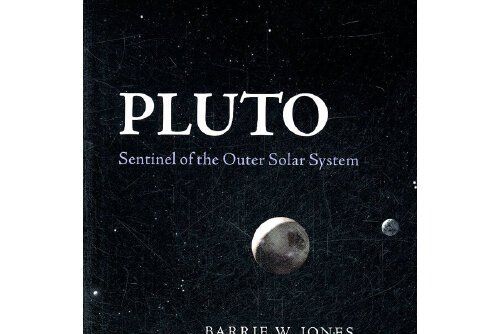《pluto》是2010年8月Cambridge University Press出版的圖書,作者是Barrie W. Jones。
基本介紹
- 中文名:pluto
- 作者:Barrie W. Jones
- 出版社:Cambridge University Press
- ISBN:9780521194365

《pluto》是2010年8月Cambridge University Press出版的圖書,作者是Barrie W. Jones。
Pluto是一個主打smart casual的潮流品牌。它的獨特的剪裁,以及超高的性價比將自身品牌區別於高價位專注於設計的設計師品牌和以銷售為主流行感較弱的二線品牌。Pluto在對設計方面有著較高的要求同時,價格又非常親民。可以說是一個誰都“潮”的起的品牌。很好的契合了“實用性平價潮流”的理念。是次,Pluto推出經典...
《Pluto》是原作日本漫畫家手塚治虫,由日本漫畫家浦澤直樹改編的科幻漫畫,改編自《鐵臂阿童木》中的地上最大機器人篇,於2003年開始連載,2009年完結,單行本由國小館出版,共8卷。該漫畫講述了機器人PLUTO殺害其他機器人,突出了人類和機器人共存的矛盾。作品介紹 浦澤直樹漫畫作品,改編自手塚治虫作品《鐵臂阿童木...
蓋吉希特(Gesicht):歐盟刑警特別搜查官,標準德國人的樣子。歐盟刑警投入巨資的結晶。家庭成員有妻子海琳娜。在跟PLUTO戰鬥後被阿布拉博士派來的機器人殺害。人物——地上最強七大機器人 蒙布朗(Mont Blanc):39次戰爭中隸屬陸軍是一位偉大的機器人詩人,一位熱愛大自然的男人,終年在瑞士阿爾卑斯山與自然為伴。被...
《Pluto》是台灣女歌手鄭宜農的一張音樂專輯,收錄11首歌曲,發行於2017年4月28日。創作背景 《Pluto》的名字源自因質量過小且運行軌道怪異,而被剔除於九大行星之外的冥王星。身為太陽系中離地球最遠的星球,冥王星一直以來給人遙遠神秘的印象,直到2015年太空探測船「新視野號」終於拍攝到清楚的影像,科學家對於它...
核心代號Pluto(冥王星,又被簡稱為K7核心)。Pluto(冥王星)核心Athlon採用0.25μm(0.25μm等於250nm)工藝,Slot A接口,支持Alpha系統匯流排協定EV6,擁有2200萬個電晶體,核心面積184平方毫米,核心頻率500MHz~700MHz。它具有100MHz外頻、200MHz前端匯流排,擁有128KB一級快取、512KB二級快取。 所以說樓主,你這個連第一代...
PLUTO普魯托,描寫的是未來架空幻想的故事。描寫的是未來架空幻想的故事。雖然又是人類的愚蠢將科技發展到極至。然後被自己開發出來的機器人反咬一口。這類並不大陌生的故事。但依然精采的令人拍手叫好。主角不是人類。而是跟人類幾乎一模一樣的機器人。 未來是人類跟機器人並存的世界。機器人一樣有工作,身分,地位。
《pluto》是2010年8月Cambridge University Press出版的圖書,作者是Barrie W. Jones。內容簡介 Orbiting at the edge of the outer Solar System, Pluto is anintriguing object in astronomy. Since the fascinating eventssurrounding its discovery, it has helped increase our understandingof the origin and ...
《PLUTO 冥王》是Netflix將推出的動畫劇集,根據漫畫《PLUTO》改編,由 GENCO 出品,M2STUDIO 負責動畫製作,於2023年10月26日上線Netflix。作品簡介 《PLUTO 冥王》根據漫畫《PLUTO》改編,被眾人譽為傑作的漫畫《PLUTO》改編自手塚治虫於 1964 年推出的《Astro Boy ‘The Greatest Robot on Earth’》,由浦澤...
《pluto/布魯圖 006》是2009年文化傳信出版的圖書,作者是浦沢直樹、手塚治虫。內容介紹 布魯圖、高志、阿布拉、撒哈特…追趕著不斷出現,神秘人物正體的基斯克,終於都找出潛伏在連續機器人被殺事件背後,可怕的動機…!作者介紹 浦尺直樹,1960年出生,東京府中市人。大學畢業後,即以第一本作品「Return」入選國小...
《pluto/布魯圖 007》是2009年文化傳信出版社出版的圖書,作者是浦沢直樹、手塚治虫。內容介紹 地上七體最強的機器人,被布魯圖破壞了六體後,現只餘下和平主義者.艾普斯朗。拒絕服兵役,收養戰爭遺孤,心地善良的他,終於都要踏上戰場!能夠自由操縱無限太陽能量的他,是布魯圖最大的強敵。作者介紹 浦尺直樹,...
Pluto的真實姓名是厲程,山東青島人,高中曾就讀美術專業,之後改修戲劇文學 ,就讀於中央戲劇學院。作品 《雙生》(暢銷15萬冊)《不離》(暢銷10萬冊)《小命運》《深度依賴》的作者。曾學過書法國畫,曾於十三歲至十五歲在雜誌發表文章。所獲榮譽 曾獲全國第八屆少年作家杯徵文比賽一等獎。作品特點 將Pluto用...
科美Pluto SW 2(100GB)是一款2.5英寸的硬碟。重要參數 存儲容量:100GB 接口類型:SATA2 數據傳輸率:連續讀(數據可壓縮):275MB/s...硬碟尺寸:2.5英寸 記憶體架構:MLC多層單元 平均尋道時間:0.1ms 其它性能:寫壽命(日均寫1TB):15年 讀...其它特點:掉電保護 過載保護 超穩定性 ...外形尺寸:...
《pluto/布魯圖 005》是2008年文化傳信出版的圖書,原作是浦沢直樹 / 手塚治虫。內容介紹 負責調查機器人連續被殺事件的基斯克,發現事件背後,機器人跟人類之間,存在著憎恨的感情,不久,他自身的討厭記憶亦變得清晰…作者介紹 浦尺直樹,1960年出生,東京府中市人。大學畢業後,即以第一本作品「Return」入選國小...
科美Pluto SW 2(50GB)是一款硬碟,硬碟尺寸是2.5英寸 重要參數 存儲容量:50GB 接口類型:SATA2 數據傳輸率:連續讀(數據可壓縮):285MB/s...記憶體架構:MLC多層單元 平均尋道時間:0.1ms 其它性能:寫壽命(日均寫1TB):7年 讀壽...其它特點:掉電保護 過載保護 超穩定性 ...外形尺寸:100.2±0.25...
《pluto/布魯圖 002》是2006年文化傳信出版社出版的圖書,作者是浦沢直樹、手塚治虫。內容介紹 超級機器人連環被摧毀,離奇兇殺案接連發生!現場留下類似「角」的物體,到底犯案動機是甚麼,真兇又是誰呢?追查事件的刑警基斯克,遇上阿童木…作者介紹 浦尺直樹,1960年出生,東京府中市人。大學畢業後,即以第一...
科美Pluto SW 2(400GB)是一款電子產品,其存儲容量:400GB,接口類型:SATA2 重要參數 數據傳輸率:連續讀(數據可壓縮):250MB/s...硬碟尺寸:2.5英寸 記憶體架構:MLC多層單元 平均尋道時間:0.1ms 其它性能:寫壽命(日均寫1TB):60年 讀...其它特點:掉電保護 過載保護 超穩定性 ...外形尺寸:100....
《pluto/布魯圖 004》作者手塚治虫,文化傳信出版社出版。內容介紹 接連不斷被破壞的世界有名機器人、波拉調查團成員被殺等這些充滿謎團事件的關鍵,竟全都掌握在阿童木製造者,天馬博士的手上?作者介紹 浦尺直樹,1960年出生,東京府中市人。大學畢業後,即以第一本作品「Return」入選國小館新人漫畫大賞。1986年...
《PLUTO~冥王~》作者是手塚治虫。【作 者】浦沢直樹/畫 手塚治虫/原作 【劇情介紹】這是一個人類與機器人一起共同生活的時代。瑞士的超高性能機器人「蒙布朗」在森林大火中遭到不明的破壞。而在不久之後,德國的機器人法擁護團體幹部也被發現陳屍於自宅。歐洲警察聯邦的機械刑警蓋吉特,從種種跡象判斷這兩起...
科美Pluto SW 2(200GB)是一款硬碟,硬碟尺寸是2.5英寸 重要參數 數據傳輸率:連續讀(數據可壓縮):280MB/s...記憶體架構:MLC多層單元 其它性能:寫壽命(日均寫1TB):30年 讀...其它特點:掉電保護 過載保護 超穩定性 ...外形尺寸:100.2±0.25*69.9±0.25*9.3±0...產品重量:75.25±0.5g...
科美Pluto SV 2(100GB)是一款2.5英寸的硬碟。重要參數 存儲容量:100GB 接口類型:SATA2 數據傳輸率:連續讀(數據可壓縮):280MB/s...硬碟尺寸:2.5英寸 記憶體架構:SLC單層單元 平均尋道時間:0.1ms 其它性能:寫壽命(日均寫1TB):30年 讀...其它特點:掉電保護 過載保護 超長壽命 ...外形尺寸:...
科美Pluto SV 2(25GB)是一款2.5英寸的硬碟。重要參數 存儲容量:25GB 接口類型:SATA2 數據傳輸率:連續讀(數據可壓縮):280MB/s...硬碟尺寸:2.5英寸 記憶體架構:SLC單層單元 平均尋道時間:0.1ms 其它性能:寫壽命(日均寫1TB):7年 讀壽...其它特點:掉電保護 過載保護 超長壽命 ...外形尺寸:100...
冥王星(Pluto,小行星編號為134340,天文符號為♇)是柯伊伯帶中的矮行星。冥王星是被發現的第一顆柯伊伯帶天體,第一顆類冥天體,是太陽系內已知體積最大、質量第二大的矮行星。在直接圍繞太陽運行的天體中,冥王星體積排名第9,質量排名第10。冥王星是體積最大的外海王星天體,其質量僅次於位於離散盤中的鬩...
改編自手塚治虫作品《地上最強機器人》的浦澤直樹漫畫《PLUTO》,在今天(6月14日)傳來了將要動畫化的訊息。根據知名網站Crunchyroll在法國安納西國際動畫電影節的現場報導,浦澤直樹x手塚治虫的漫畫《PLUTO》宣布本作動畫化決定。手塚治虫大師在原來的故事中,以天馬博士的身份製造出用於和阿童木戰鬥用的機器人PLUTO...
控水下機器人,又稱Pluto無人潛航器,是義大利研製的一種掃雷用的遙控潛水器,是用於海域掃雷的潛水器,專門用於掃雷作業 控水下機器人,又稱Pluto無人潛航器,是義大利研製的一種掃雷用的遙控潛水器,是用於海域掃雷的潛水器,專門用於掃雷作業的遙控潛水器,用於以探測、清除海域的水雷障礙,以避免不必要的人員傷亡...
《小命運》是2008年中國畫報出版社出版的圖書,作者是pluto。該書講述了兩個男孩孤獨成長的故事,關於命運與諾言,至死不渝的愛。內容簡介 天使本無性別。當愛上女人,便成為男人。當愛上男人,便成為女人。而當兩個天使相愛,他們的愛將無界,也更純粹。愛,就是愛。《小命運》,A TRICK OF FATE,命運的...
《狗和貓的時間》是由上海致敬文化傳播有限公司出品和製作、亞華湖院線聯合出品的中文版音樂劇。2023年3月17日在上海共舞台首演。劇情簡介 黑貓Pluto在街道出生,並一直生活在那裡。在一次激烈的領地鬥爭之後,Pluto因為眼睛受傷而被人類救助,待在人類的家裡接受治療。討厭人類的Pluto為了回到自己的領地從房子裡逃了...
